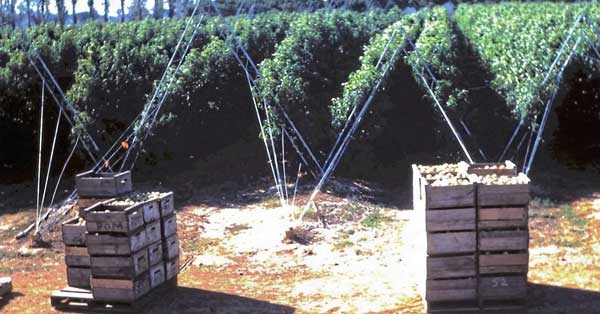Blueprint for efficient orchard: In 1973 the time was ripe to combine the different fields of expertise to develop a blueprint of a modern and efficient orchard system.
One for the orchardist to follow throughout the life of the planting.
The blueprint was to integrate tree density, arrangement of trees, and training and pruning to maintain the desired configuration.
Added to this was soil management to maintain optimum growing conditions, efficient use of water for irrigation, use of irrigation water to manipulate growth and cropping, mechanical harvesting of the crop, mechanical trimming of the canopy in summer, designing special equipment to apply sprays efficiently, and an economic evaluation.
The blueprint also included the development of cheap methods for orchardists to propagate their own canning peach and pear trees from cuttings.
This type of research became known as systems research because knowledge from various disciplines was integrated to form the Tatura Trellis.
Tree design
The tree design with the most commercial promise for canning peaches had only two limbs, which grew out at right angles across the inter-row traffic lane.
The limbs were trained up in the form of a V at an angle of 30 degrees to the vertical towards corresponding limbs in the adjacent row.
As the name implied, the trees of the Tatura Trellis were trellised and intensively trained until they reached full size.
These trees were smaller than those in the old free-standing open vase system.
Planting density
In July 1973 the first experimental planting was established to determine the optimum planting density.
Tree densities ranged from 1111 to 6666 Golden Queen peach trees per hectare. The size of the experimental block was 0.3 ha.
Trellis design
The first trellis consisted of elaborate steel structures of A-frames joined to make Vs.
The tops of the A-frames were later cut off to allow a specially built mechanical pruner to pass through the rows and reach inside the V-canopies.
A number of other trellis materials made of steel and wood were experimented with, but the final trellis structures consisted of treated pine poles.
The 3-metre rows proved to be too hard to manage and were changed to 6-metre rows. The non-statistically designed experiment was flexible so that we could change the new system and ensure that orchardists could easily manage it.
First peach crop
The first crop was harvested in 1975, 20 months after the peach trees were planted.
The canning-grade yields ranged from 18 to 30 tonnes per hectare. Canning peach trees that were conventionally grown would not crop until they were at least four years old.
The outstanding early performance of the Tatura Trellis created much interest among local orchardists and people associated with the fruit industry.
In 1975, the late John Cornish established the first commercial planting at his Willowbank orchard, with canning peach trees grown from cuttings.
Ross and Bruce Turnbull, and Jack and Andrew Simson also planted canning peach trees on Tatura Trellis.
All plantings were close to the Tatura Research Institute and these pioneers were major players in the canning fruit industry.
Another Tatura Trellis planting was established in South Africa by Rhodes Fruit Farms.
Other crops
Experiments with apricot and pear started in 1975 followed by apple, nashi, cherry, plum, persimmon, table and wine grape and peaches for the fresh market.
Specific methods of training were developed to suit the different growth and fruiting habits of these types of fruit trees and grapevines.
Mechanisation
A grant from the Rural Bank gave the go ahead for design and construction of a mechanical pruner and harvester.
Another harvester was manufactured in West Australia for the West Australian Department of Agriculture, and tested at Tatura.
Promotion
The virtues of the Tatura Trellis were widely publicised through field days, workshops, Agnotes, research reports and numerous articles in local, national and overseas papers, and in agricultural and horticultural magazines.
A series of scientific papers were published, and a Ph.D. thesis on, Calculation of potential photosynthesis in closed canopies in orchards of trellis type was completed.
Visitors from every state in Australia and from all over the world came to the Tatura Research Institute to find out what this new research was all about.
Introduction to the world—the 20th International Horticultural Congress
In 1978, only five years after it had all started, a unique opportunity arose for the Tatura Trellis to be introduced to the horticultural world at the 20th International Horticultural Congress in Sydney.
Several Tatura researchers gave a cohesive account that centred on the concept and early results of the Tatura Trellis
(Continued next issue)
See this article and photos in Tree Fruit December 2013






















